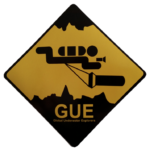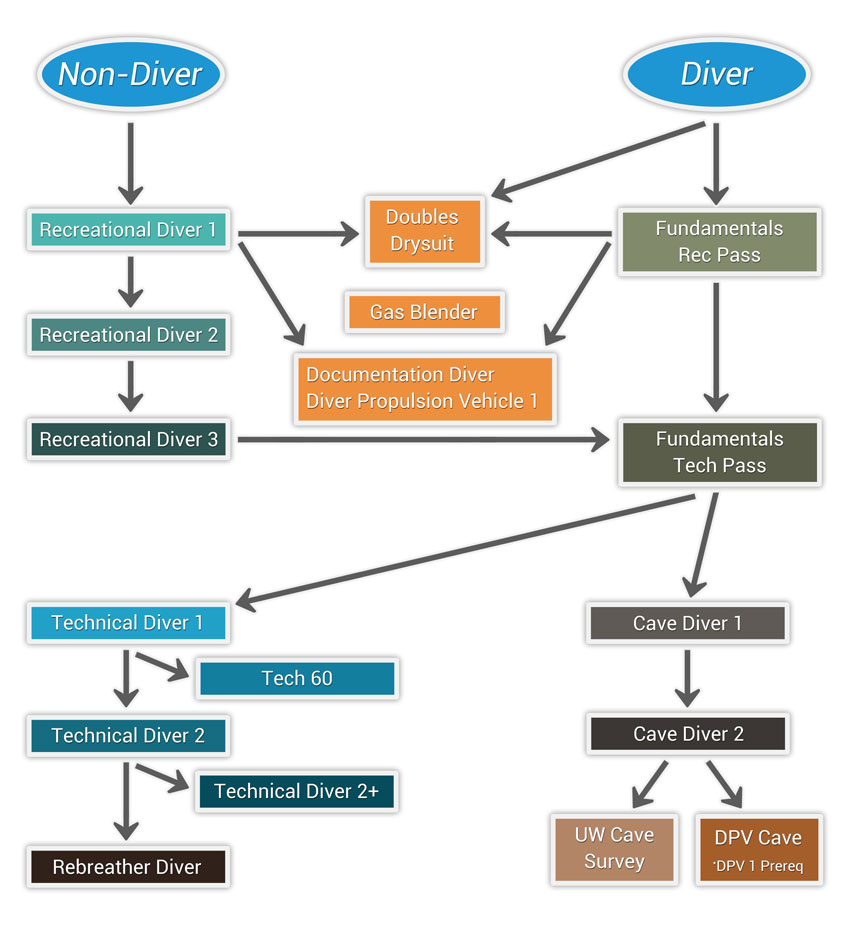PADI DiveMaster
I thought becoming a PADI divemaster would put me into an elite stage in scuba diving. However, after a few dives in Monterey, CA, I’m quickly learning that I have barely scraped the surface into scuba diving. There are so many more things that I need to learn. I feel confident that I can help other PADI open water divers and advanced open water divers, but I want to challenge myself.
Global Underwater Explorers (GUE)
 Up until a few weeks ago, I had no idea GUE even existed. Another divemaster at my new shop introduced me to his fellow GUE divers. He explained to me that this was another diving organization. His short explanation to me was that it teaches all divers to dive use the same equipment configuration, dive in group formation, and a higher level of buoyancy and trim requirements. Essentially it means, whenever you dive with another GUE person, you always expect the same type of diver. You could dive with someone you just met, and feel like you have been dive buddies for years.
Up until a few weeks ago, I had no idea GUE even existed. Another divemaster at my new shop introduced me to his fellow GUE divers. He explained to me that this was another diving organization. His short explanation to me was that it teaches all divers to dive use the same equipment configuration, dive in group formation, and a higher level of buoyancy and trim requirements. Essentially it means, whenever you dive with another GUE person, you always expect the same type of diver. You could dive with someone you just met, and feel like you have been dive buddies for years.
Comparison between PADI and GUE
PADI or GUE? Something to think about. While working in Iceland, I always approached the first dive with caution. How will this person’s buoyancy be? will they know how to control their BCD? if GUE was enforced, would these concerns be minimized? I think so. I think PADI OW does a great job of introducing people to the water. But GUE could be the the next step in ensuring safety and standards. During my divemaster course, I did find it difficult when the equipment setups were different. The buddy check before diving ensured that I knew what to do in case of a rescue scenario.
Conclusions
I definitely think GUE is worth a try for people that are serious about diving. I’m curious to try it out. Here’s an image on the course diagram from the GUE website:

I’m interested in the Fundamentals Rec Pass. The GUE website gives the following information for the course:
The Fundamentals course is normally conducted over four days, requires 6 dives and at least 30 hours instruction, encompassing classroom, land drills and in-water work.
GUE Fundamentals Specific Training Standards
- Student-to-instructor ratio is not to exceed 8:1 during land drill or surface exercises; it cannot exceed 4:1 during any in-water training.
- Critical skills may only be performed up to a maximum depth of 30 feet/9 meters
- Two dives must be at a depth of at least 25 feet/8 meters
- Maximum depth 60 feet/18 meters
- No overhead diving
- No decompression
Academic Topics
- Introduction: GUE organization and course overview (objectives, limits, expectations)
- Building a solid skill base – buoyancy, trim, balance and propulsion
- Fundamental diving skills
- Streamlining and equipment configuration
- Situational awareness
- Dive planning and gas management
- Breathing gas overview
- Nitrox
- Decompression overview and minimum decompression procedures
- Diving safety and accident prevention
- The GUE system
Land Drills and Topics
- Dive team protocols
- Basic Five
- S-drill and valve-drill
- Equipment fit and functions
- Propulsion techniques
- Pre-dive drills
- Surface marker deployment
- Diver rescue techniques (Fundamentals Tech)
Required Dive Skills and Drills for Fundamentals Rating
(A) Required Dive Skills and Drills for a Fundamentals-Recreational Rating
- Must be able to swim at least 300 yards/275 meters in less than 14 minutes without stopping. This test should be conducted in a swimsuit and, where necessary, appropriate thermal protection.
- Must be able to swim a distance of at least 50 feet/15 meters on a breath hold while submerged.
- Demonstrate proficiency in safe diving practices; this would include pre-dive preparation, in-water activity, and post-dive assessment.
- Demonstrate awareness of team member location and a concern for safety, responding quickly to visual indications and dive partner requirements.
- Demonstrate good buoyancy and trim, i.e. approximate reference is a maximum of 30 degrees off horizontal while remaining within 5 feet/1.5 meters of a target depth.
- Demonstrate proficiency in lift bag/surface marker buoy deployment while using a spool.
- Efficiently and comfortably demonstrate how to donate gas to an out-of-gas diver in multiple gas-sharing scenarios.
- Efficiently and comfortably demonstrate how to donate gas to an out-of-gas diver followed by an ascent to the surface, utilizing minimum decompression.
- Demonstrate a safe and responsible demeanor throughout all training.
- Demonstrate proficiency in underwater communication.
- Demonstrate a comfortable demeanor while swimming without a mask, in touch contact.
- Demonstrate aptitude in the following open water skills: mask clearing, mask removal and replacement, regulator removal and exchange, long-hose deployment.
- Demonstrate safe ascent and descent procedures.
- Demonstrate proficiency in executing a valve drill.
- Demonstrate basic equipment proficiency and an understanding of the GUE equipment configuration.
- Demonstrate three propulsion techniques. Students should demonstrate comprehension of the components necessary for a successful backward kick.
(B) Required Dive Skills and Drills for a Fundamentals-Technical Rating
This rating is required for those trainees seeking entry into GUE’s Cave and Technical courses. Skills 14-19 must be graded as a 3 or higher.
- Must be able to swim at least 300 yards/275 meters in less than 14 minutes without stopping. This test should be conducted in a swimsuit and, where necessary, appropriate thermal protection.
- Must be able to swim a distance of at least 50 feet/15 meters on a breath hold while submerged.
- Demonstrate proficiency in safe diving practices; this would include pre-dive preparation, in-water activity, and post-dive assessment.
- Demonstrate awareness of team member location and a concern for safety, responding quickly to visual indications and dive partner requirements.
- Demonstrate good buoyancy and trim, i.e. approximate reference is a maximum of 20 degrees off horizontal while remaining within 3 feet/1 meter of a target depth.
- Demonstrate proficiency in the ability to deploy a surface marker buoy while using a spool.
- Efficiently and comfortably demonstrate how to donate gas to an out-of-gas diver in multiple gas-sharing episodes.
- Efficiently and comfortably demonstrate how to donate gas to an out-of-gas diver followed by an ascent to the surface, utilizing minimum decompression.
- Demonstrate a safe and responsible demeanor throughout all training.
- Demonstrate proficiency in underwater communication.
- Demonstrate a comfortable demeanor while swimming without a mask, in touch contact.
- Demonstrate aptitude in the following open water skills: mask clearing, mask removal and replacement, regulator removal and exchange, long-hose deployment.
- Demonstrate safe ascent and descent procedures.
- Demonstrate an efficient valve drill with double tanks.
- Demonstrate basic equipment proficiency and an understanding of the GUE equipment configuration.
- Demonstrate proficiency in four propulsion techniques that would be appropriate in delicate and/or silty environments; students should also demonstrate competence in the backward kick and helicopter turns.
- Demonstrate proficiency with a primary light by using it during all skills except SMB deployment.
- Demonstrate diver rescue techniques, including effective management of an unconscious diver underwater.
Wow- lots more than the generic PADI courses. In addition, the GUE equipment requirements is to have a blackplate system (versus BCD), a long hose and neck line regulator configuration, and primary and backup lights. In pinging previous GUE graduates, they estimate the costs of the new fundamental courses to be about $800-900. The new equipment costs would also add another $1000. So, this beginner course is starting to compare to the PADI instructor course costs. If I am a fulltime divemaster, it would essentially take me about 6 months to save up enough money to start this course. I never thought I would transition into a cave or tech diver, but GUE has a good course outline. Who knows what I might try in the next 6 months.
